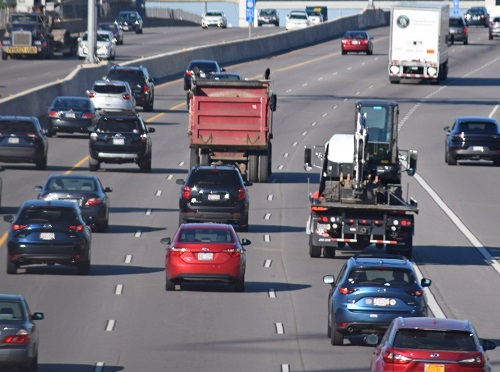A new report indicates that U.S. traffic fatalities fell in 2023 for the second straight year; three years after traffic fatalities surged in 2020 and 2021 as the nation grappled with the impact of the COVID-19 pandemic.
[Above photo by Wisconsin DOT]
However, the report indicated that despite those declines over the past two years, traffic fatalities in 2023 remained significantly higher than a decade ago.
That report – issued by national transportation research nonprofit TRIP and entitled “Addressing America’s Traffic Safety Crisis: Examining the Causes of Increasing U.S. Traffic Fatalities and Identifying Solutions to Improve Traffic Safety”– documents trends in traffic fatalities from 2013 to 2023 at the national and state levels, examines causes for the increase in traffic fatalities, and prescribes a broad, comprehensive approach to reducing traffic fatalities in the U.S.

The number and rate of U.S. traffic fatalities increased dramatically in 2020 and 2021, as driver behavior and travel patterns changed at the beginning of the COVID-19 pandemic in March 2020. However, following the sharp increase during the pandemic, U.S. fatalities have fallen in 2022 and 2023. Despite progress in recent years, in the decade from 2013 to 2023, U.S. traffic fatalities are 25 percent higher compared to the previous decade, with the fatality rate per 100 million vehicle miles of travel or VMT higher by 15 percent as well.
Bicyclist and pedestrian fatalities, which accounted for 21 percent of all U.S. traffic fatalities in 2023, increased 18 percent from 2018 to 2023.
From 2018 to 2023, the number of pedestrians killed increased 16 percent (from 6,482 to 7,522) and the number of bicyclists killed increased 29 percent (from 859 to 1,105) the report noted.
Based on the traffic crash cost methodology used by the National Highway Traffic Safety Administration, TRIP estimates that fatal and serious traffic crashes in 2023 caused a total of $1.85 trillion in the value of societal harm, which includes $460 billion in economic costs and $1.4 trillion in quality-of-life costs.
NHTSA data also found that the number of people killed in speeding-related traffic crashes climbed 21 percent from 2018 to 2023, and represented 28 percent of U.S. traffic fatalities in 2023. From 2018 to 2022, the number of fatalities in distraction affected traffic crashes increased by 16 percent – from 2,858 to 3,308.
From 2018 to 2022, crashes in U.S. highway work zones resulted in 4,316 fatalities, increasing 18 percent from 756 in 2018 to 891 in 2022.

“While it is good news that the number of traffic fatalities is trending downward in recent years, the sharp increase in traffic fatalities over the past decade must be addressed,” said Dave Kearby, TRIP’s executive director, in a statement.
“Making a commitment to eliminating fatal and serious injuries on the nation’s roadways will require robust investment and coordinated activities by transportation and safety-related agencies,” he noted.
“That includes providing layers of protection for the nation’s motorists, pedestrians and bicyclists, including safe road users, safe roads, safe vehicles, safe speeds and high-quality post-crash care,” Kearby pointed out.
“We are experiencing what can only be described as a crisis on our roadways as it relates to safety, and it is imperative that transportation agencies address this crisis using all means and methods at our disposal,” added Craig Thompson, president of the American Association of State Highway and Transportation Officials and secretary of the Wisconsin Department of Transportation.
“AASHTO is a firm supporter of the U.S. Department of Transportation’s National Roadway Safety Strategy and believes we all play a role in eliminating fatalities on our nation’s roadways,” Thompson noted.
“State departments of transportation are continuously looking for solutions to alleviate this crisis and sharing best practices through avenues like AASHTO’s Safety Summit, which will convene again this fall, to bring together transportation leaders and practitioners to help apply safety principles through the transportation project lifecycle, ultimately saving more lives,” he said.
 Top Stories
Top Stories
Modal Administrators Speak at AASHTO Annual Meeting
December 5, 2025 Top Stories
Top Stories

